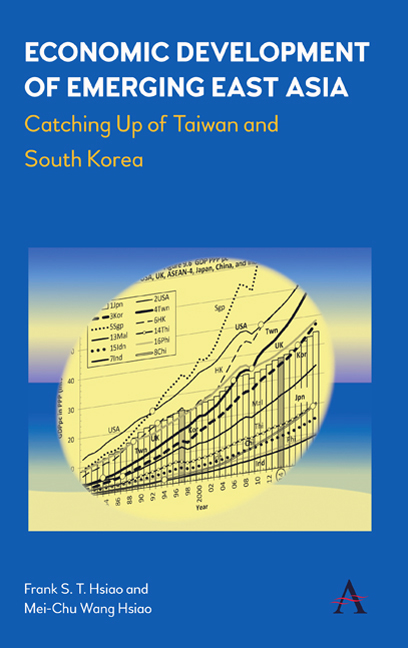Book contents
- Frontmatter
- Dedication
- Contents
- List of Figures
- List of Tables
- Sources of the Chapters
- Acknowledgments
- About the Authors
- Introduction
- Part I Studies of Emerging East Asian Economies: Taiwan and Korea
- 1 Some Development Indicators of Taiwan: A Comparative Study of East Asia in the Early Postwar Period
- 2 Capital Flows and Exchange Rates during the Asian Financial Crisis: Recent Korean and Taiwanese Experiences and Challenges
- 3 Productivity Growth in Newly Developed Countries: The Case of Korea and Taiwan
- 4 Korean and Taiwanese Productivity Performance: Comparisons at Matched Manufacturing Levels
- 5 Colonialism, Learning and Convergence: A Comparison of India and Taiwan
- Part II Catching Up and Convergence in East Asian Economic Growth
- Index
3 - Productivity Growth in Newly Developed Countries: The Case of Korea and Taiwan
from Part I - Studies of Emerging East Asian Economies: Taiwan and Korea
Published online by Cambridge University Press: 10 January 2018
- Frontmatter
- Dedication
- Contents
- List of Figures
- List of Tables
- Sources of the Chapters
- Acknowledgments
- About the Authors
- Introduction
- Part I Studies of Emerging East Asian Economies: Taiwan and Korea
- 1 Some Development Indicators of Taiwan: A Comparative Study of East Asia in the Early Postwar Period
- 2 Capital Flows and Exchange Rates during the Asian Financial Crisis: Recent Korean and Taiwanese Experiences and Challenges
- 3 Productivity Growth in Newly Developed Countries: The Case of Korea and Taiwan
- 4 Korean and Taiwanese Productivity Performance: Comparisons at Matched Manufacturing Levels
- 5 Colonialism, Learning and Convergence: A Comparison of India and Taiwan
- Part II Catching Up and Convergence in East Asian Economic Growth
- Index
Summary
Abstract
Using the weighted Malmquist productivity index, the efficiency index and the technical index, this chapter compares the productivity growth of 15 matched manufacturing sectors of Korea and Taiwan. The distance functions are derived by using industry-wide production frontiers from 1979 to l996. We find that the efficiency growth rates for both countries are high and are the predominant component of productivity. We also find that technology and productivity growth rates are much higher in Taiwan than in Korea. At a disaggregated level, there is more similarity in technology growth, but less or no similarity in efficiency growth. In both countries, productivity growth is similar, but traditional industries rely more on efficiency, basic industries on technology and high-tech industries on both. Lastly, in the innovator analysis, we found that the petroleum and coal products sector was consistently the major innovator of the manufacturing industry in both countries, but the minor innovators differed.
Introduction
Since the Asian financial crisis of 1997, it has become clear that the “East Asian Economic Miracle” has its limits. The Asian NIEs and the Association of Southeast Asian Nations (ASEAN) countries have fallen into recession and face the prospect of a productivity slowdown. Taiwan and South Korea (hereafter Korea), the most prominent “twins” among the impressive Asian performers, are no exception. This chapter compares productivity growth and its two components, technical progress and efficiency change, at the matched manufacturing levels of the two countries during 18 years (1979–96) before the financial crisis set in.
The importance of productivity growth in the study of the economic development of nations cannot be overemphasized. Productivity growth is “the single most important indicator of any nation's economic performance in the long run” (Lester, 1998), and “for real economic miracles you have to look to productivity growth […] In terms of human welfare, there is nothing that matters as much in the long run” (Baumol et al., 1989). Indeed, Korea and Taiwan can claim long-run “miracle growth” in the twentieth century. From 1911 to 1992, the average annual growth rate of real GDP per capita of Taiwan was 3.04%, and of Korea, 2.98%. The two ranked second and third in long-run world development, surpassed only by Japan, which had 3.34%.
- Type
- Chapter
- Information
- Economic Development of Emerging East AsiaCatching Up of Taiwan and South Korea, pp. 59 - 92Publisher: Anthem PressPrint publication year: 2017



